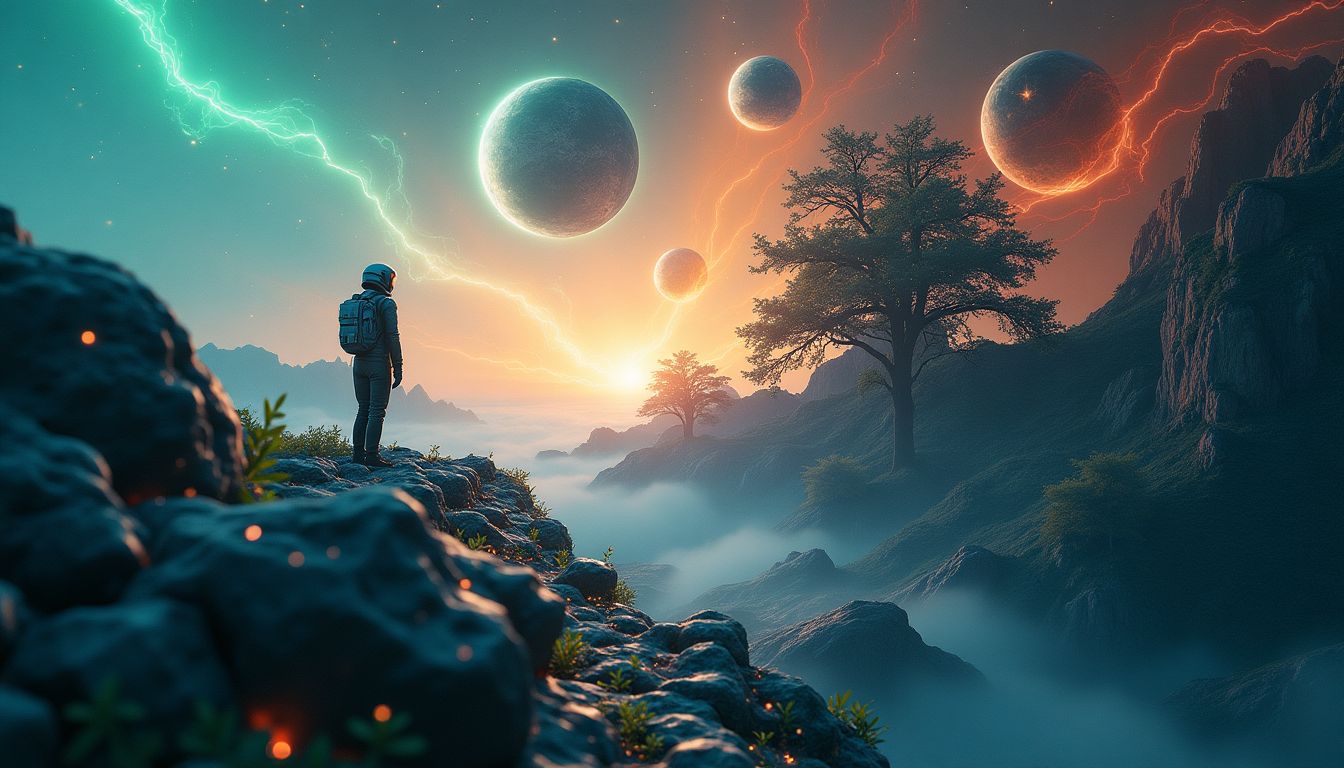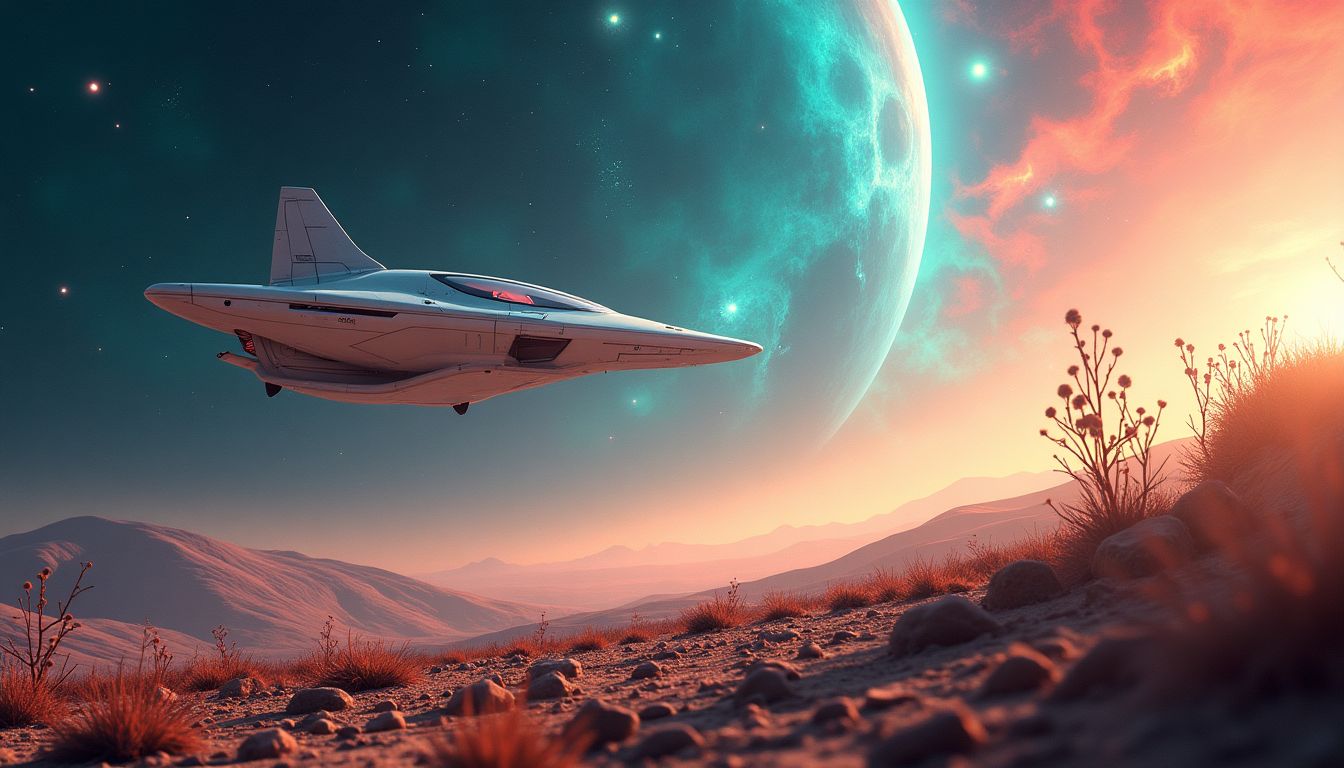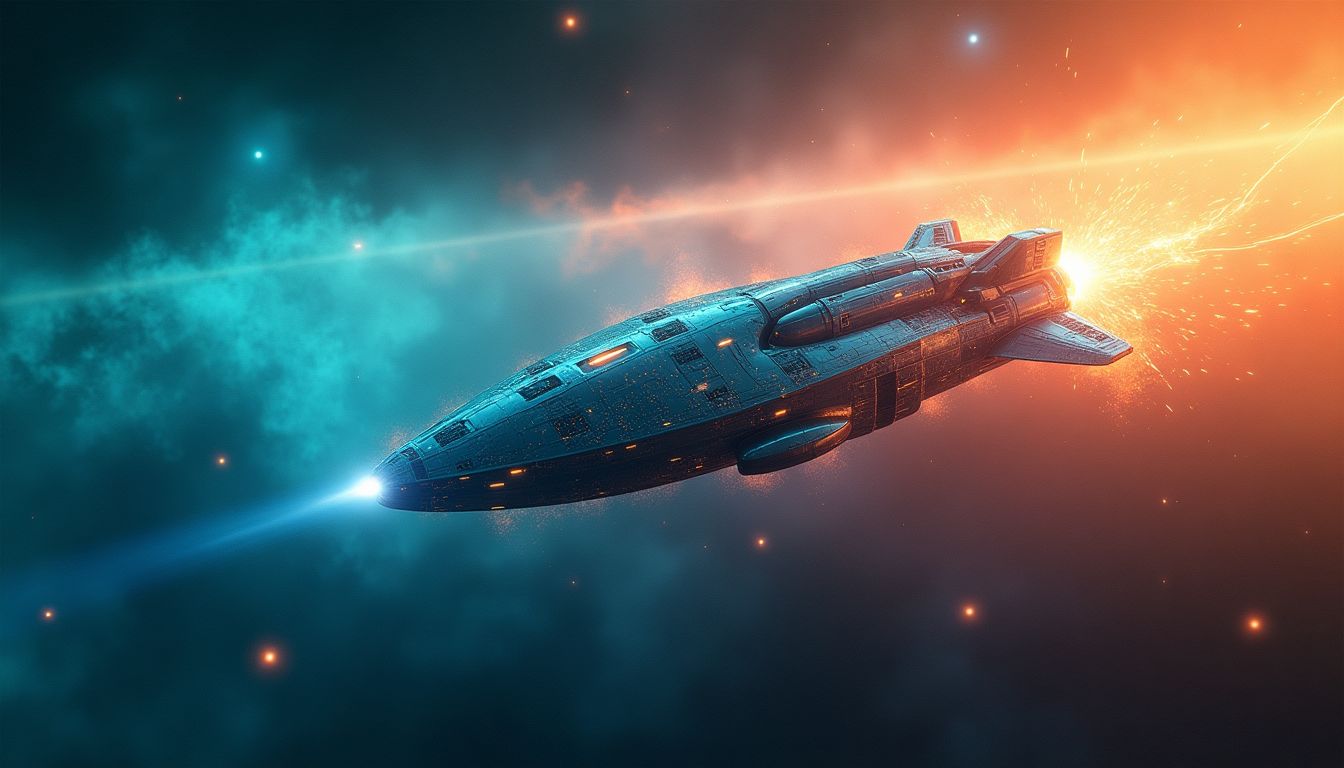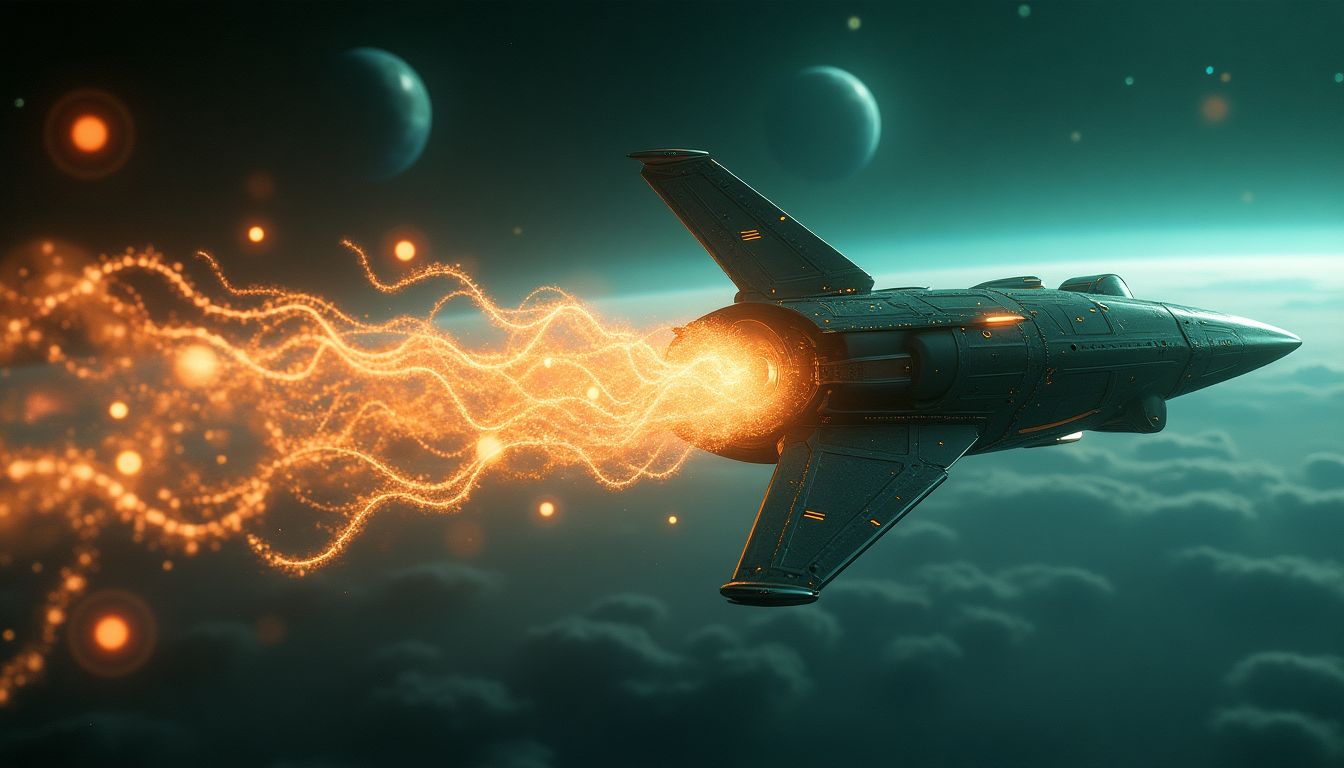What if humanity’s greatest legacy wasn’t built on Earth but scattered across the stars, carried by self-replicating, AI-driven spacecraft? This isn’t the plot of a sci-fi blockbuster—it’s a real possibility that scientists like Carl Sagan, Freeman Dyson, and Michio Kaku have pondered for decades. Interstellar seed ships, powered by artificial intelligence, could be the key to spreading life beyond our solar system, terraforming distant planets, and ensuring the survival of life as we know it.
The idea is as bold as it is beautiful. Imagine spacecraft, no bigger than a refrigerator, zipping through the cosmos, armed with AI brains and a cargo of life-sustaining microbes, plants, and terraforming tools. Their mission? To find barren worlds, kickstart ecosystems, and lay the groundwork for future civilizations. It’s like sending a cosmic gardener to plant seeds in the universe’s backyard—except this gardener is a robot, and the backyard is light-years away.
But why AI? Because space is vast, unpredictable, and downright hostile. Sending humans on these missions would be like mailing a postcard to Mars and hoping it arrives by next Tuesday. AI, on the other hand, can process data faster than a caffeinated physicist, adapt to unforeseen challenges, and operate autonomously for centuries. It’s the ultimate multitasker, capable of navigating asteroid fields, analyzing planetary atmospheres, and even building new spacecraft from scratch using materials found in space.
This article dives into the science, challenges, and ethical dilemmas of interstellar seed ships. From the nuts and bolts of designing these AI-driven marvels to the philosophical questions about humanity’s role in the cosmos, we’ll explore how this audacious vision could become reality. So buckle up—this isn’t just a journey through space; it’s a journey through the future of life itself.
1. The Concept of Interstellar Seed Ships
1.1 What Are Interstellar Seed Ships?
Interstellar seed ships are autonomous spacecraft designed to carry life-sustaining materials—like microbes, plants, and advanced terraforming tools—to distant planets. Think of them as cosmic Johnny Appleseeds, but instead of planting apple trees, they’re planting the seeds of entire ecosystems. Their mission? To transform barren, lifeless worlds into thriving habitats capable of supporting future life forms.
These ships wouldn’t just drop off a few microbes and call it a day. They’d be equipped with AI systems capable of analyzing planetary conditions, deploying the right mix of organisms, and even building infrastructure like greenhouses and energy sources. It’s a multi-step process that could take centuries, but with AI at the helm, patience is a built-in feature.
1.2 Historical and Scientific Inspiration
The idea of interstellar seed ships isn’t new. Science fiction legends like Arthur C. Clarke explored similar concepts in works like The Songs of Distant Earth, where humanity sends out ships to preserve life after Earth’s destruction. On the scientific side, the concept of Von Neumann probes—self-replicating machines designed for space exploration—has been a staple of astrobiology discussions for decades.
Even Stephen Hawking weighed in on the idea, suggesting that humanity’s survival might depend on spreading beyond Earth. While Hawking was more focused on colonizing other planets, the underlying principle is the same: life is too precious to keep in one basket, especially when that basket is floating in the vacuum of space.
1.3 Why AI Is Essential
Let’s face it: space is a terrible place for humans. The distances are mind-boggling, the environments are harsh, and the timelines are, well, astronomical. Sending humans on interstellar missions would be like trying to row a canoe across the Pacific—it’s possible, but you’d better pack a lot of snacks.
AI, on the other hand, is perfectly suited for the job. It doesn’t need food, water, or oxygen. It doesn’t get bored or lonely. And it can process vast amounts of data in real time, making split-second decisions that could mean the difference between success and failure. Whether it’s navigating through a treacherous asteroid field or figuring out how to terraform a planet with a toxic atmosphere, AI is the ultimate problem-solver.
But AI’s role goes beyond just solving problems. It’s also about adaptability. Space is full of surprises, and no amount of planning can account for every possible scenario. AI systems can learn from their mistakes, adjust their strategies, and even collaborate with other AI systems to tackle challenges. It’s like having a team of super-smart, tireless scientists working around the clock to ensure the mission’s success.
2. Identifying Suitable Target Planets
2.1 The Search for Habitable Worlds
Finding the perfect planet for interstellar seeding is like trying to find a needle in a cosmic haystack. Luckily, AI-driven telescopes like those used in the Kepler and TESS missions are already scanning the skies for exoplanets with conditions that could support life. Think liquid water, stable atmospheres, and temperatures that don’t boil or freeze your socks off. These telescopes gather massive amounts of data, and AI is the ultimate matchmaker, sifting through it to find Earth 2.0 candidates.
2.2 Filtering Candidates
Not all planets are created equal. Some are too hot, others too cold, and some are just plain weird. AI algorithms would analyze planetary data to prioritize targets based on factors like proximity, atmospheric composition, and geological stability. For example, a planet with a carbon dioxide-rich atmosphere might be a great candidate for terraforming, while one with sulfuric acid clouds? Not so much. AI would essentially play the role of a cosmic real estate agent, helping us pick the best "fixer-upper" planets in the galaxy.
2.3 Ethical Considerations
Here’s where things get tricky. What if the planet we’re eyeing already has its own life forms, even if they’re just microbes? Do we have the right to interfere? These are questions that keep ethicists up at night. Seeding life on another planet is a monumental responsibility, and humanity would need to tread carefully. We’d need to balance our desire to spread life with the ethical duty to preserve potential extraterrestrial ecosystems. It’s the ultimate cosmic dilemma: to seed or not to seed?
3. Designing the Seed Ships
3.1 Engineering Challenges
Building a seed ship is no walk in the park. These spacecraft need to be lightweight, durable, and capable of operating for centuries in the harsh conditions of space. Advances in materials science, like the development of graphene, could make them both strong and light. Propulsion systems are another hurdle. Traditional chemical rockets won’t cut it for interstellar travel, so we’re looking at alternatives like solar sails or ion drives. It’s like trying to build a car that can drive across the ocean—except the ocean is space, and the car is a high-tech life-seeding machine.
3.2 Self-Replication Capabilities
Inspired by Von Neumann probes, seed ships could be designed to replicate themselves using raw materials found in space. Imagine a swarm of seed ships, each capable of building more ships from asteroids or other cosmic debris. This self-replication capability would allow for exponential exploration, sending out waves of seed ships to terraform multiple planets. It’s like a cosmic chain reaction, but instead of explosions, we’re spreading life.
3.3 Containment Systems for Life
Protecting biological cargo during a potentially centuries-long journey is another massive challenge. We’re talking about microbes, plants, and maybe even animal DNA. These life forms need to survive the harsh radiation, extreme temperatures, and vacuum of space. Innovative containment systems, like cryogenic storage or radiation-shielded biospheres, would be essential. Think of it as a high-tech lunchbox for life, keeping everything fresh for the long haul. Because nothing says “cosmic disaster” like opening your seed ship and finding a bunch of expired bacteria.
4. The Terraforming Process
Terraforming is the process of transforming a barren, lifeless planet into one that can support life. It’s like taking a blank canvas and painting a thriving ecosystem. But how could AI-driven interstellar seed ships accomplish this monumental task? Let’s break it down step by step.
4.1 Deploying Microbial Life
The first step in terraforming is often the simplest in theory but revolutionary in impact: deploying microbial life. Microbes are nature’s ultimate engineers. They can survive in extreme conditions, process minerals, and even alter atmospheric compositions. For example, cyanobacteria helped oxygenate Earth’s atmosphere billions of years ago, paving the way for complex life.
Seed ships could carry a microbial payload, including extremophiles—organisms that thrive in harsh environments. These microbes could:
- Break down minerals to release essential nutrients.
- Produce oxygen or other gases to modify the atmosphere.
- Create soil by breaking down rocks, enabling plant life to take root.
AI would monitor the microbial activity, adjusting conditions to maximize their effectiveness. Think of it as a planetary-scale science experiment, with AI as the lead scientist.
4.2 Climate Engineering
Once microbes lay the groundwork, the next challenge is stabilizing the planet’s climate. This is where AI’s problem-solving prowess shines. Climate engineering involves large-scale interventions to create a stable, habitable environment. Here’s how AI could tackle this:
- Introducing Greenhouse Gases: To warm a cold planet, AI could release gases like methane or carbon dioxide to trap heat.
- Building Solar Shields: For a planet too close to its star, AI could deploy reflective mirrors or aerosols to reduce incoming radiation.
- Managing Water Distribution: AI could melt ice caps or redirect water to create oceans, rivers, and lakes.
These strategies would be tailored to each planet’s unique conditions, ensuring a balanced and sustainable climate.
4.3 Building Habitats
With a stable climate and basic life forms in place, the final step is constructing habitats for more complex organisms. This is where robotics and AI truly team up. Autonomous machines could:
- Build shelters from local materials, reducing the need for Earth-based resources.
- Construct greenhouses to grow plants, providing food and oxygen.
- Set up energy systems, such as solar panels or geothermal generators, to power the habitat.
Imagine an army of robotic builders, guided by AI, transforming a barren landscape into a thriving ecosystem. It’s like watching a city rise from the desert, but on an interplanetary scale.
5. Ethical and Philosophical Implications
While the idea of interstellar seed ships is undeniably exciting, it raises profound ethical and philosophical questions. Who are we to play the role of cosmic gardeners? What responsibilities do we have to potential extraterrestrial life? Let’s dive into these complex issues.
5.1 The Responsibility of Seeding Life
Seeding another planet with life is a monumental responsibility. It’s not just about survival—it’s about stewardship. We must consider:
- Potential Harm: Could we inadvertently destroy native life forms, even microbial ones?
- Ecological Balance: Are we prepared to manage the long-term consequences of introducing life to a new world?
- Ethical Oversight: Who decides which planets to terraform and how?
These questions highlight the need for global collaboration and ethical guidelines to govern interstellar seed missions.
5.2 Preserving Biodiversity
One of the most compelling reasons for interstellar seed ships is preserving Earth’s biodiversity. Climate change, habitat destruction, and other threats are driving countless species to extinction. Seed ships could carry DNA banks, storing genetic material from endangered species. This would:
- Serve as a biological backup, ensuring the survival of Earth’s diverse life forms.
- Provide a foundation for cloning or reintroducing species in the future.
- Act as a living library, preserving the genetic heritage of our planet.
It’s like creating a cosmic Noah’s Ark, with AI as the caretaker.
5.3 The Role of AI in Decision-Making
Handing over control of interstellar missions to AI raises questions about accountability. What happens if an AI makes a catastrophic error? How do we ensure its decisions align with human values? To address these concerns, we could:
- Program ethical principles into AI systems, prioritizing preservation and non-interference.
- Create oversight mechanisms, allowing humans to intervene if necessary.
- Develop transparent AI models, enabling us to understand and audit its decisions.
Ultimately, AI would act as an extension of humanity’s will, guided by our shared values and aspirations.
6. AI Solutions: How Would AI Tackle This Issue?
6.1 Problem-Solving Framework
AI would approach interstellar seed missions as a multi-layered optimization problem, balancing factors like energy efficiency, mission duration, and success probability. By breaking down the mission into smaller, manageable tasks, AI could prioritize actions based on real-time data and predictive modeling. For instance, AI could calculate the most efficient trajectory to a target planet while conserving fuel and minimizing exposure to cosmic radiation. This framework would allow AI to adapt to unforeseen challenges, such as asteroid fields or gravitational anomalies, ensuring the mission stays on track.
6.2 Data-Driven Decision Making
Using machine learning, AI would analyze vast datasets from space missions and simulations to refine strategies for navigation, terraforming, and resource management. For example, data from NASA's Kepler Mission and the TESS Mission could help identify the most promising exoplanets. AI could also simulate terraforming scenarios, predicting how different interventions—like introducing microbes or altering atmospheric composition—would impact a planet's habitability. This data-driven approach would maximize the chances of success while minimizing risks.
6.3 Adaptive Systems
AI would continuously learn and adapt to new challenges, ensuring mission resilience in unpredictable environments. For example, if a seed ship encounters a malfunction, AI could diagnose the issue, reroute resources, and even manufacture replacement parts using onboard 3D printers. This adaptability would be crucial for long-duration missions, where human intervention is impossible. AI could also adjust terraforming strategies based on real-time feedback, such as changes in a planet's climate or geological activity, ensuring the mission remains on course.
6.4 Collaborative Networks
AI systems on different seed ships could communicate and share knowledge, creating a distributed intelligence network for faster problem-solving. Imagine a fleet of seed ships exploring different regions of the galaxy, each contributing data and insights to a shared database. This collaborative approach would accelerate the discovery of habitable worlds and improve the efficiency of terraforming efforts. For instance, if one seed ship successfully terraforms a planet, its AI could share the strategy with other ships, enabling them to replicate the process on similar worlds.
6.5 Ethical AI Oversight
Incorporating ethical principles into AI programming would ensure responsible decision-making and minimize harm to potential extraterrestrial ecosystems. AI could be programmed to prioritize non-invasive terraforming methods, such as using microbes to gradually alter a planet's atmosphere, rather than drastic interventions like nuclear explosions. Additionally, AI could be designed to detect signs of existing life and avoid interfering with it, ensuring that humanity's expansion into the galaxy is both ethical and sustainable.
Action Schedule/Roadmap (Day 1 to Year 2)
Day 1: Assemble a Core Team
Recruit leading scientists in AI, astrobiology, and aerospace engineering to begin conceptualizing the project. Key personnel could include experts from institutions like NASA, SpaceX, and MIT. The team should also include ethicists and philosophers to address the moral implications of interstellar seeding.
Week 1: Define Objectives
Establish clear goals, such as mission parameters, target planets, and ethical guidelines. This phase should involve extensive brainstorming sessions and consultations with stakeholders, including government agencies, private companies, and academic institutions. The objectives should be ambitious yet achievable, balancing scientific exploration with ethical considerations.
Month 1: Conduct Feasibility Studies
Assess the technological and financial requirements of interstellar seed ships, drawing on data from existing space missions. This phase should include a detailed cost-benefit analysis, as well as a review of current technologies and their potential for improvement. Feasibility studies should also explore the legal and regulatory frameworks governing space exploration and terraforming.
Year 1: Develop AI Algorithms
Create machine learning models for navigation, terraforming, and autonomous decision-making. This phase should involve extensive testing and validation, using simulations and real-world data to refine the algorithms. Collaboration with AI research labs, such as those at DeepMind and OpenAI, could accelerate the development process.
Year 1.5: Build Prototypes
Construct and test small-scale seed ship models to validate key technologies. Prototypes should include all essential components, such as propulsion systems, AI modules, and biological containment units. Testing should take place in controlled environments, such as space simulation chambers, to ensure the prototypes can withstand the rigors of interstellar travel.
Year 2: Launch First Mission
Deploy a prototype seed ship to a nearby exoplanet, marking the first step in humanity’s interstellar quest. The mission should be closely monitored, with real-time data transmitted back to Earth for analysis. Success in this initial mission would pave the way for larger, more ambitious projects, bringing us closer to the dream of spreading life across the galaxy.
The Cosmic Legacy: Humanity’s Role in the Galaxy
The concept of interstellar seed ships challenges us to think beyond the confines of our planet and imagine a future where life flourishes across the galaxy. By harnessing the power of AI, humanity could become the architects of this cosmic transformation, ensuring the survival of life and expanding our understanding of the universe. This vision is not just about exploration; it’s about legacy. It’s about leaving a mark on the cosmos that will endure long after our sun has burned out.
While the challenges are immense, the potential rewards are even greater. From terraforming distant worlds to preserving Earth’s biodiversity, interstellar seed ships offer a vision of hope and exploration that transcends borders and generations. Imagine a galaxy teeming with life, each planet a testament to humanity’s ingenuity and determination. This is not just a dream; it’s a possibility within our grasp, if we dare to reach for it.
As we stand on the brink of this new frontier, let us embrace the possibilities and work together to turn this dream into reality. The journey will be long, and the obstacles will be many, but the rewards—both scientific and philosophical—are beyond measure. Let us take the first step, not just for ourselves, but for all the life that may one day call the galaxy home.
What do you think? Should humanity take on the role of galactic gardeners, or should we leave the cosmos untouched? Share your thoughts in the comments below, and don’t forget to subscribe to our newsletter for more insights into the future of space exploration. Together, we can build a brighter future among the stars.
FAQ
1. What is the purpose of interstellar seed ships?
Interstellar seed ships are designed to carry life-sustaining materials, like microbes and plants, to distant planets. Their goal is to start the process of making these planets habitable for future life forms. Think of them as cosmic gardeners, planting the seeds of life across the galaxy.
2. How would AI be involved in these missions?
AI would be the brain of the operation. It would handle everything from navigating the vastness of space to making decisions about where and how to terraform planets. AI’s ability to process huge amounts of data and adapt to new challenges makes it perfect for these missions. For example, AI systems like those developed by NASA for space exploration could be adapted for seed ships.
3. Are there risks to seeding other planets?
Yes, there are risks. One big concern is the possibility of interfering with any existing extraterrestrial life. We also need to think about the ethical implications of changing another planet’s environment. What if our actions have unintended consequences? These are questions scientists and ethicists are already debating.
4. How long would these missions take?
These missions could take a very long time—centuries or even millennia. That’s why AI is so important. Humans wouldn’t be able to oversee such long missions, but AI can operate autonomously for extended periods. For example, missions to nearby star systems like Proxima Centauri could take decades just to reach their destination.
5. What technologies are needed for seed ships?
Several advanced technologies are crucial for interstellar seed ships:
- Propulsion Systems: To travel vast distances quickly, we’d need breakthroughs in propulsion, like SpaceX’s Starship or nuclear propulsion.
- Materials Science: The ships must be lightweight yet durable to survive the harsh conditions of space.
- AI and Robotics: Autonomous systems to navigate, terraform, and make decisions.
- Biotechnology: To preserve and deploy biological cargo, like microbes and DNA banks.
6. Could seed ships carry humans?
Not initially. The first seed ships would likely carry only microbes, plants, and robotic systems. However, once a planet is terraformed, it could become a destination for human colonization. Think of it as laying the groundwork for future generations to follow.
7. What are Von Neumann probes, and how do they relate to seed ships?
Von Neumann probes are theoretical self-replicating machines proposed by mathematician John von Neumann. These probes could build copies of themselves using raw materials found in space. Seed ships could use similar technology to replicate and explore multiple planets simultaneously, making the mission more efficient.
8. How would seed ships find habitable planets?
AI-driven telescopes, like those used in NASA’s Kepler mission, would scan the galaxy for exoplanets with conditions suitable for life. Factors like the presence of liquid water, stable atmospheres, and the right temperature would be key. AI would then analyze this data to prioritize the best candidates.
9. What ethical concerns are there with interstellar seed ships?
There are several ethical concerns:
- Interfering with Alien Life: What if we accidentally harm or destroy existing extraterrestrial ecosystems?
- Moral Responsibility: Do we have the right to alter other planets, even if it’s for the greater good?
- AI Autonomy: Giving AI control over such missions raises questions about accountability and unintended consequences.
10. Could seed ships help preserve Earth’s biodiversity?
Absolutely! Seed ships could carry DNA banks containing genetic material from Earth’s plants and animals. This would act as a cosmic backup, ensuring that even if species go extinct on Earth, their genetic legacy could live on elsewhere. Organizations like the Svalbard Global Seed Vault are already working on similar projects here on Earth.
11. What’s the biggest challenge for interstellar seed ships?
The biggest challenge is the sheer scale of the mission. Traveling to distant planets requires overcoming enormous distances, harsh environments, and the need for long-term autonomy. Advances in AI, propulsion, and materials science will be critical to making this vision a reality.
12. Could private companies like SpaceX or Blue Origin lead these missions?
It’s possible! Companies like SpaceX and Blue Origin are already pushing the boundaries of space exploration. With their focus on innovation and cost-efficiency, they could play a key role in developing the technologies needed for interstellar seed ships.
13. What’s the first step in making interstellar seed ships a reality?
The first step is assembling a team of experts in AI, astrobiology, and aerospace engineering. From there, we’d need to define clear objectives, conduct feasibility studies, and start developing the necessary technologies. It’s a long road, but every journey begins with a single step.
14. How can I learn more about space exploration and AI?
There are plenty of resources out there! Check out organizations like NASA, SpaceX, and SETI for the latest updates. You can also explore books and documentaries on space exploration and AI to dive deeper into the topic.
15. What’s the ultimate goal of interstellar seed ships?
The ultimate goal is to ensure the survival and expansion of life beyond Earth. By spreading life to other planets, we’re not just securing humanity’s future—we’re also enriching the universe with the diversity and beauty of life. It’s a bold vision, but one that could redefine our place in the cosmos.
Wait! There's more...check out our gripping short story that continues the journey: The Last Gardener
Disclaimer: This article may contain affiliate links. If you click on these links and make a purchase, we may receive a commission at no additional cost to you. Our recommendations and reviews are always independent and objective, aiming to provide you with the best information and resources.
Get Exclusive Stories, Photos, Art & Offers - Subscribe Today!




























Post Comment
You must be logged in to post a comment.